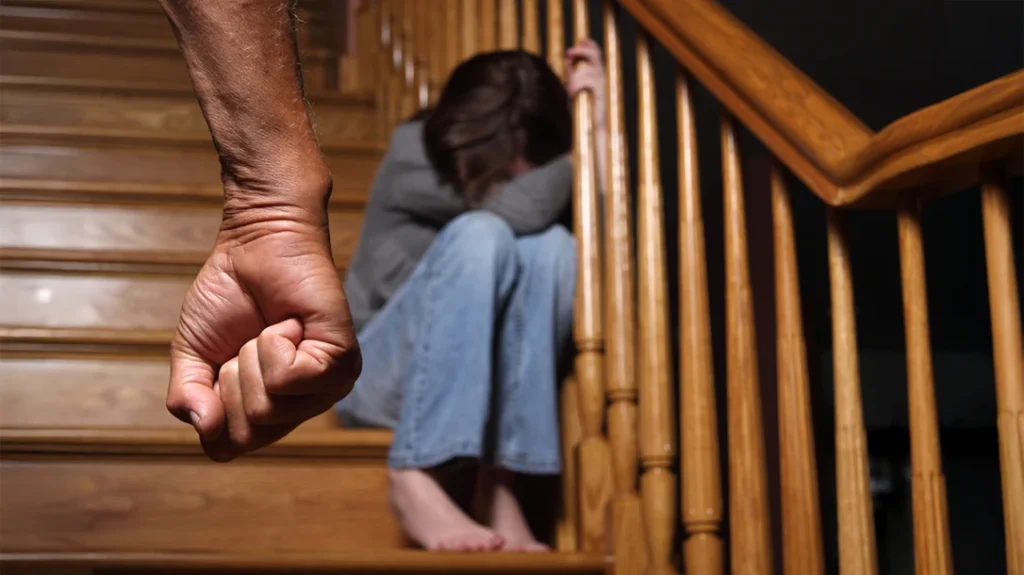Choosing a pocket pistol can be a daunting task, especially with so many choices in compact handguns. However, selecting a gun and holster is just part of the problem. You also need to choose a proper pocket in which to carry it so you can draw it quickly and reliably if you ever need it. This process of “picking a pocket” should take into consideration concealability, comfort, accessibility, mobility, pocket size, and compatibility of that method of carry with your entire wardrobe. With these basic criteria in mind, let’s take a look at the advantages and disadvantages of carrying in the most common pocket pistol locations.
Front And Back Pockets
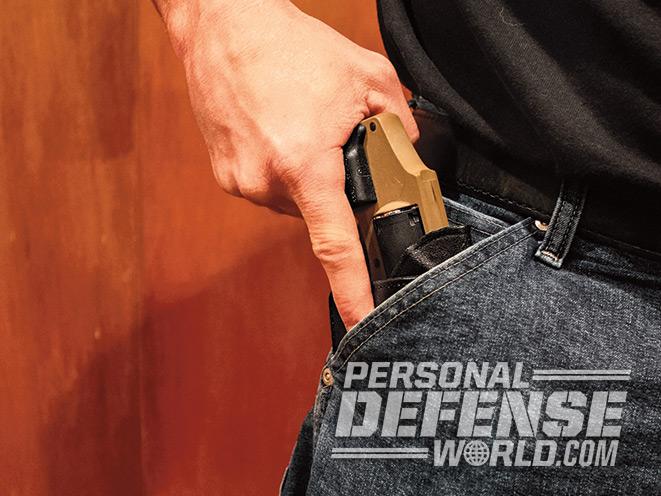
The front pants pocket is probably the most classic in-pocket carry position. It was the favorite of many old-school gunfighters like J.H. Fitzgerald—especially since the fashion of the time-favored baggy pants with deep pockets. Front pockets are good because they accommodate larger guns (including revolvers). They support weight well and are easily accessible for a standard draw. They are also excellent for surreptitious draws in which the hand is “prepped” on the gun before it is pulled from the pocket, primarily because it’s natural to put your hand in that pocket.
Advertisement — Continue Reading Below
RELATED STORY: 5 Tips For Perfecting Your Pocket Draw
On the negative side, front-pocket carry doesn’t conceal or draw well with tighter pants, and it can be uncomfortable for some people. It also does not work well with movement. This is because it tends to trap your hand in the pocket when you step.
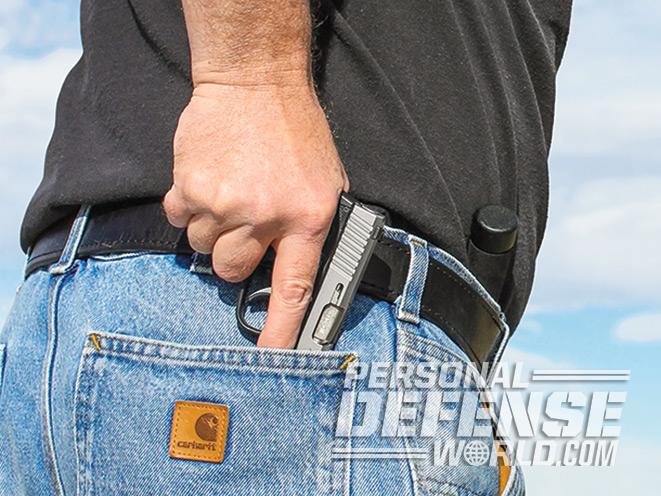
Back-pocket carry works best with patch-style pockets, like those found on jeans. The interior pockets of dress pants don’t support the weight of a holstered gun well. They also tend to snag and turn inside out during a draw. Since you’ll literally be sitting on the gun, this style of carry is most comfortable with flat, small-framed pocket pistols. It does not work well with revolvers. Accessibility is very good with a standard draw and surreptitious draws work surprisingly well. This is because the body naturally hides the gun and the movement of the gun arm. You can also use an “I’ll give you my wallet” ruse to naturally reach for the gun without arousing suspicion.
Advertisement — Continue Reading Below
RELATED STORY: Massad Ayoob – Press-Out vs. Index Draw
Compared to the front pocket, carrying in the back pocket offers excellent mobility and even allows you to draw while moving. If you’re into the saggy-pants hipster look or spend most of your day sitting, it may not be a good choice. For everyone else, it’s well worth considering.
Cargo Pocket Carry
I know several well-respected firearms trainers who are die-hard advocates of cargo-pocket carry. Cargo pockets are roomy enough to accommodate even the largest pocket-friendly pistols and revolvers. However, they can sometimes be so large that they don’t stabilize the gun well or maintain it in a consistent orientation. To solve this problem, I recommend Chris Fry’s ModuLoader Pocket Shield from Raven Concealment Systems. It provides a stable, extremely versatile platform in the pocket.
Cargo pockets conceal guns extremely well and allow good mobility. However, during rapid movement or running, the weight of the pocket pistol can cause it to swing excessively and bang against your leg. Since most cargo pockets have a flap of some sort and are positioned farther down the leg, access is not as fast or convenient and “sneaky” draws are not particularly sneaky. Perhaps the major disadvantage of cargo-pocket carry is that it limits your fashion choices to cargo-style pants.
Advertisement — Continue Reading Below
Jacket Pocket
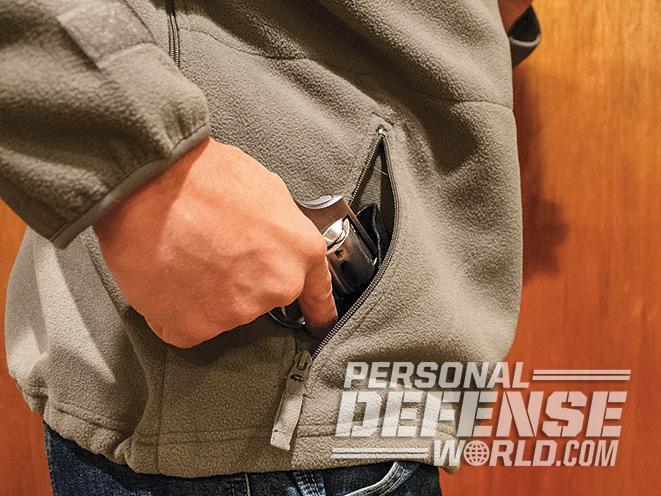
Another way to carry is in a jacket pocket. Choose a jacket heavy enough to support the weight of a pocket gun, yet light enough to be worn at all times. It allows easy access to the gun and conceals it well. It also offers outstanding mobility during the draw, and is hands-down the easiest way to “prep” a draw by naturally putting your hand in your pocket.
RELATED STORY: 21 of the Best Carry Pistols Currently Available
The downside of this style of carry is that you must always retain control of the jacket. Also, it works best when the front of the jacket is zippered or buttoned. If it’s not, the weight of the gun tends to make it swing around and may create a “lopsided” appearance that announces its presence. This can be counterbalanced by carrying spare ammo or a flashlight in the opposite-side pocket. A closed front is still more stable.
Advertisement — Continue Reading Below
Stay Consistent
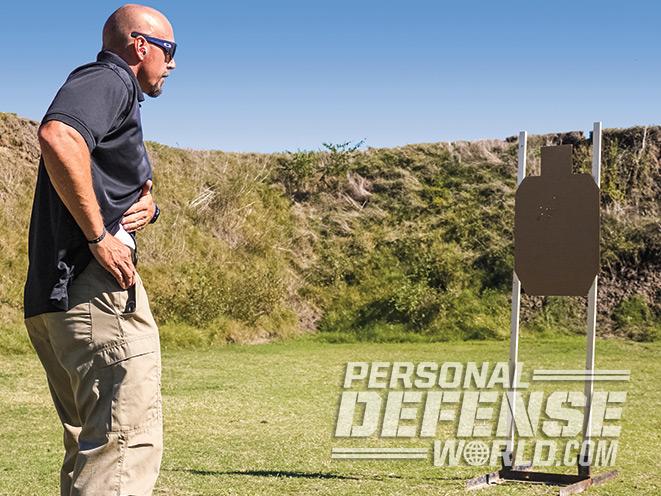
Drawing a pocket pistol in self-defense should be a well-trained reflex. Building that kind of reflex requires consistent habits in training and in the carry location of your pistol. If you carry in one location when you’re dressed casually and somewhere else when you’re in a suit, under stress you may end up reaching for a gun that isn’t there. This wastes precious, potentially deadly seconds while you shift gears.
RELATED STORY: 12 Proven Concealed Carry Pistols for Self Defense
To really consider the advantages of these different carry positions, take a critical look at the way you dress. Pay close attention to the details of the pockets in your most commonly worn clothing.
Advertisement — Continue Reading Below
Once you think you have your carry position dialed in, test drive your choice of gun, holster and pocket at home before you carry in public. Initially, work with an empty gun or, even better, a gun loaded with dummy rounds to better approximate its weight when loaded. Personal defense is all about personal choices; there is no one-size-fits-all solution. Do your homework, experiment and pick your pocket carefully.




